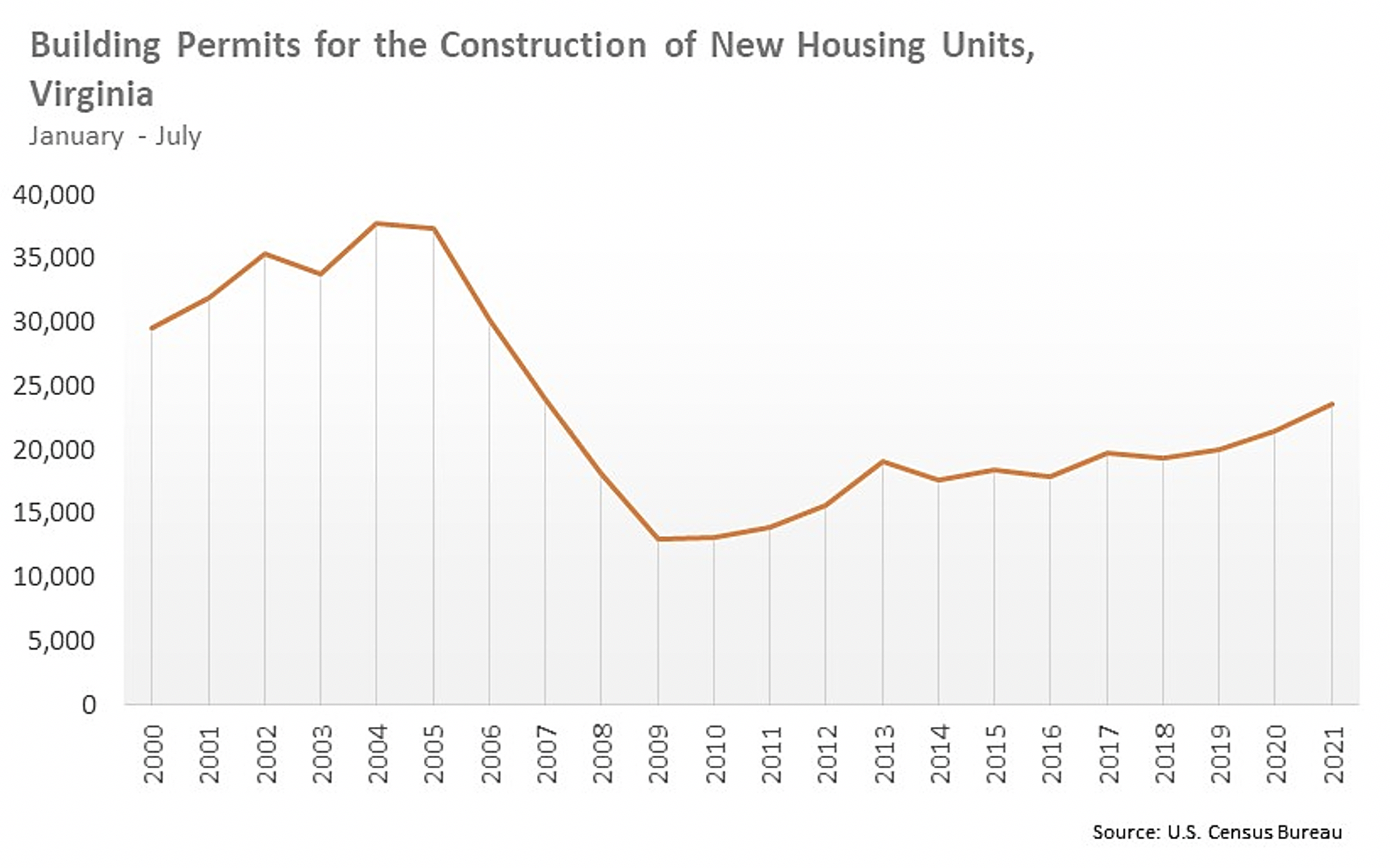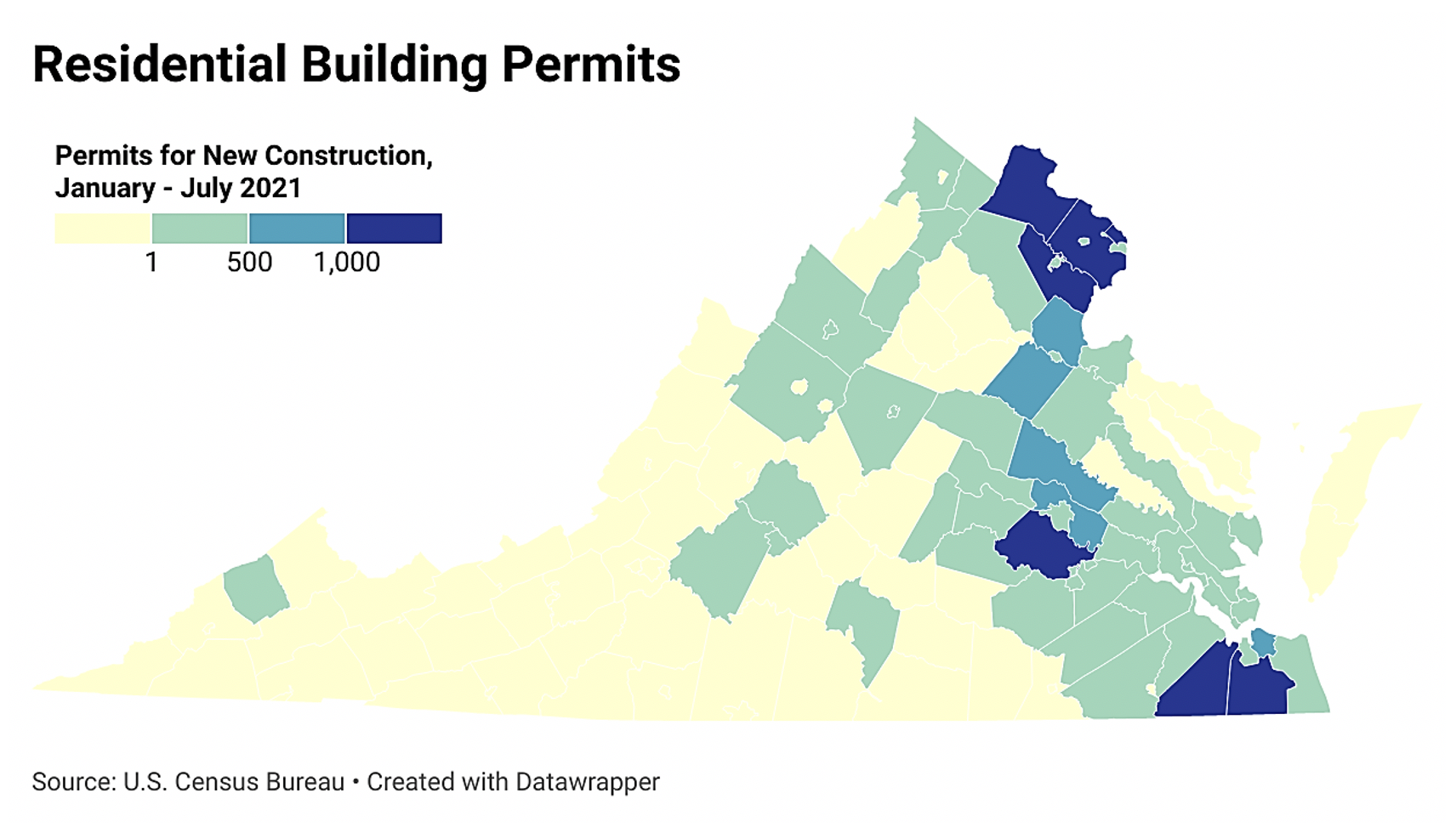New Housing Construction in Virginia Slowed This Summer
September 7, 2021
After several months of strong new construction activity in Virginia, the number of permits issued for the construction of new housing units fell this summer. In July, there were 2,973 new residential construction permits issued statewide, which is down 16.4% from June and is 32.1% lower than July 2020.
There has been a bigger slowdown this summer in single-family construction. Between June and July, the number of permits issued for the construction of single-family homes dropped 21%, while permits for new multifamily construction edged down 2.9%. Over the past few years, permitting activity has risen between June and July in Virginia.
The slowdown this spring follows several months when new housing construction appeared to be on the rise. Year-to-date, January through July, there have been a total of 23,500 permits issued for the construction of new housing units in Virginia, which is up 9.4% from 2020 and is up 17.3% over 2019.

New residential construction in 2021 has been highly concentrated in the state’s Golden Crescent, an area stretching from Northern Virginia through the Richmond region and down to Hampton Roads. The greatest numbers of permits issued in 2021 were in Chesterfield County, Prince William County, and Arlington County; the vast majority of new construction in these jurisdictions is multifamily rental construction.

Outlook for New Construction
With surging demand from homebuyers fueled by low mortgage rates and a desire for more space, new housing construction rebounded strongly during the pandemic. The inventory of existing homes fell to historically low levels and bidding wars, offers thousands of dollars over list price, and buyer concessions became the norm. Single-family builders were eager to ramp up construction to meet demand. New apartment construction that had been put on hold was re-invigorated as COVID-19 restrictions eased.
Despite continued strong demand, the pace of new housing construction has slowed this summer in many markets across the U.S. According to the National Association of Home Builders, builder confidence dropped to a 13-month low in August. There are two major reasons for the relatively sluggish new construction numbers.
- Material prices and availability. While lumber prices have begun to fall, the prices of most building materials needed for the construction of new homes remains high. In some cases, supply chain disruptions have made it impossible for builders to even source products, such as windows, siding, plumbing pipes, and electrical conduits. Higher prices and lack of materials has forced builders to slow production, even as demand remains high.
- Labor shortages. Even before the COVID-19 pandemic, homebuilders faced major challenges finding enough skilled workers, including carpenters, sheet metal installers, masons, welders, and plumbers. Builders have steadily raised wages to try to attract new workers over the past few months. There are no signs that the construction labor problems in the U.S. will improve in the near future.
New construction activity may begin to pick up in the fall, but rising costs in the industry mean that it will be more difficult to build less expensive, entry-level homes. Builders will be targeting the higher end of the market, which could open up more options for higher-income buyers but will not help expand the inventory for first-time buyers.
Construction of rental housing could increase more, as the demand for rental housing is on the rise. Apartment developers and builders will be returning to projects that may have been approved before the pandemic but had been put on hold.
Building new homes is essential for expanding the housing supply and easing price and rent pressures so that increases in the costs of housing are more in line with household income growth. The inventory of existing homes for sale has increased modestly over the past few months; however, home buyer and renter demand in most local markets—especially where there is fast job growth—continues to far outpace supply.
Residential permit data are available for Virginia’s counties and independent cities on our Research web page. If you need additional information on new housing, please contact Lisa Sturtevant.
You might also like…
Virginia’s Labor Market: Growing Sectors and Their Impact on Real Estate
By Abel Opoku-Adjei - November 4, 2024
Virginia boasts one of the strongest labor forces in the country. As of September 2024, there are 4.25 million jobs in the state, according to the Bureau of… Read More
Buyer Broker Agreement: When Do I Need One?
By Santiago Montalvo - September 6, 2024
Let’s begin with when you do NOT need one. You sign a listing agreement with a now seller and someone calls you and asks you to show that… Read More
“Can my agents sign my listing agreements and buyer-broker agreements?”
By Sean Olk - September 5, 2024
*Please note: Any questions regarding Legal Hotline Spotlights should be submitted via the Virginia REALTORS® Legal Hotline. Our attorneys are unable to respond to questions through our comments section. Q:… Read More